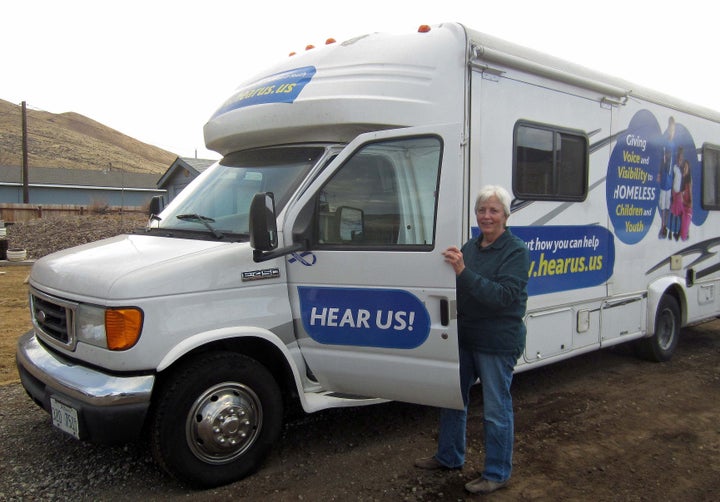
Back in November of 2005, Diane Nilan had what she now concedes may have struck some people as a “crazy notion.” She’d been working as advocate for homeless families in Illinois, getting frustrated by the glacial pace of political and bureaucratic change, when she decided to sell her town house, buy a Gulfstream motor home, and set out on the road to talk to homeless families living around the country. She drove to Pensacola, Fla., and then to Lafayette, La., and then to a tiny town in Texas, where she met a little boy who had been abandoned by his mother. She spoke with homeless children and their families at campsites and motels and shelters, and filmed them in an attempt to share what she learned.
Since then, she's become one of the country's most prominent experts on family homelessness, logging 148,000 miles and talking to families in about 30 states. So she wasn't entirely surprised when she heard the latest bleak statistic: 1 million homeless students in America, according to a report released by the Department of Education this week. Talking to the families of such students, she said, she hears "the same story time after time. Lost their job, had some medical problems, things fell apart, boom, boom, boom. Now they're living in shelters or motels."
The U.S. Education Department reported that, for the first time, the number of homeless students in America topped one million by the end of the 2010-2011 school year. These kids live in shelters and on the streets, and increasingly in hotels and on the couches of friends and relatives. On one hotel-lined stretch of highway -- a road leading to Disney World -- Nilan heard of schools where there are as many as 25 homeless students in classes of 28. The government report said 1,065,794 homeless kids were enrolled in schools in the 2010-2011 school year, an increase of 13 percent from the previous year and 57 percent since the start of the recession in 2007.
"The number is horrifyingly high but it probably is half of what the number really could be if the kids could be counted," said Nilan. The count doesn't include homeless infants, children not enrolled in school, and homeless students that schools simply failed to identify.
According to the new data, 44 states overall saw the number of homeless students increase. Fifteen states' homeless student population increased by one fifth or more. The problem is particularly pronounced in recession-addled states like Michigan, where every single county reported homeless kids in their schools. In Kentucky, the number of homeless students increased by 47 percent over one year.
While the last few years have seen the rise of an education reform movement aimed at closing the achievement gap between low-income students and their peers, the increase in homelessness threatens to stymie that effort. According to the new report, only 52 percent of the homeless students who took standardized tests were deemed to be proficient in reading, and only 51 percent passed math tests. "You don't have a permanent place to stay, you have to change schools a lot," said Barbara Duffield, policy director for the National Association for the Education of Homeless Children and Youth. "It sets you far behind. It's socially and emotionally disruptive."
Seventy-one percent of the kids identified as homeless by the Education Department listed the homes of family or friends as their primary residence. But these kids aren't counted as homeless by the U.S. Department of Housing and Urban Development, which means they can't apply for subsidized housing. "That's bogus," Nilan said. "If you talk to any families in that situation, you know they need help." A bill under consideration in Congress would change that, but some said they worry that expanding HUD's definition of homelessness would drain resources away from people who live on the streets.
Also up for consideration in Congress is a rewrite of the McKinney-Vento Act, a 1987 law that requires school systems to make sure that homeless students have a quality education (for example, by sending buses to distant neighborhoods so that the students don't have to change schools as their families move between temporary shelters). The new version of the law would give schools more tools for identifying homeless students. But the overhaul is stalled in partisan gridlock, since it's part of the package that includes the controversial No Child Left Behind act.
In the meantime, advocates like Nilan have been pondering other ways to help homeless kids. To start with, she wondered why banks can't let families stay in the foreclosed homes she sees from her Gulfstream window. It might seem like a crazy notion, but Nilan said we're dealing with a crazy problem. "The banks need to kick in some resources here to save school districts transportation money and give families some stability," she said. "These solutions are at our fingertips."